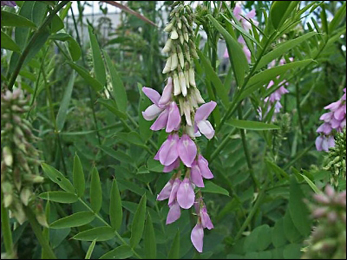Goat’s Rue (Galega officinalis) – Uses, Health Benefits and Therapeutic Effects

About Goat’s Rue
Goat’s rue (Galega officinalis) is an herbaceous plant native to the Middle East. But now has been naturalized to Western Asia and Europe. In ancient folks, goat’s rue has been narrated as a plant with high medicinal value and widely used a diuretic. It is widely cultivated as a green manure, a bee plant, a forage crop and an ornamental. It is widely cultivated as a cattle feed.
Scientific Classification:
- Kingdom – Plantae
- (Unranked) – Angiosperms
- (Unranked) – Eudicots
- (Unranked) – Rosids
- Order – Fabales
- Family – Fabaceae
- Subfamily – Papilionoideae
- Genus – Galega
- Species – G. officinalis
Goat’s rue is also commonly known by other names such as galega, goat’s-rue, French lilac, Italian Fitch, or professor-weed.
Goat’s rue is widely seen in the temperate regions, especially in the European regions. It is a perennial herb that blooms in the summer months and are widely seen in grasslands, wetlands and riverbanks. It is also ranked as an invasive weed in many parts of the world. It may reach up to a height of 1 to 1.5 m. The stem is quite glabrous. The leaves are compound and consist of 6 to 8 small leaflets with lance shaped ends. The flowers are butterfly shaped. The color of the flower varies from white, pink or blue. The seed pod is long and when it is ripe, it bursts open, scattering the seeds all around. On bruising, the plant emits a disagreeable odor. This may be the reason for the name ‘goat’s rue’.
Parts Used
Dried flowers and dried aerial parts. Flowers are best collected during July to September. Flowers are then dried well and powdered. This is used in tinctures, infusions or powders.
Chemical Constituents
Galegine, Hydroxygalegine, Guanidine, Flavones, Kaempferol, Quercetin.
Therapeutic Effects of Goat’s Rue
- The rich content of guanidine in goat’s rue has power of lowering blood glucose level and increases insulin sensitivity. Hence it is used as a supplementary treatment for type 2 diabetes mellitus. The chromium content of goat’s rue also supplement to this action.
- In clinical research, use of goat’s rue is found to reduce appetite, which can be beneficially used in weight control.
- Goat’s rue is also recommended for digestive ailments and is proven to relieve chronic constipation.
- Goat’s rue is an excellent diuretic and is very beneficial in fluid retention. It also has anti-inflammatory action.
- Goat’s rue also has antimicrobial actions. It is best used in bacterial infections. In folk medicine of medieval Europe, goat’s rue is used as an herbal tonic against worms, snake bite & bubonic plaque.
- Goat’s rue is used as a tonic for blood purification.
- Goat’s rue can stimulate the adrenal glands and pancreas and can protect the liver, in combination with other herbs.
- Goat’s rue can also act as an inhibitor of platelet aggregation.
- Goat’s rue is also used as an herbal medicine to cure tuberculosis in the ancient system of medicine.
- Research is carried out on the anticancer activity of goat’s rue. The hypothesis is made that goat’s rue can effectively fight against cancer.
- In history, there are markings that, goat’s rue can be used as a tonic in typhoid conditions. It is also mentioned that dried flowers of goat’s rue are added to boiling infusion and is taken to induce sweating during fevers. Goat’s rue has diaphoretic properties.
- Goat’s infusion is used to soak tired feet during medieval periods.
Goat’s Rue & Lactating Mothers
Is it safe to use goat’s rue for lactating mothers? This question is still under research and clinical trial. Studies show that goat’s rue while used in dried form is found to be non-toxic and can act as a galactagogue. This herb is found to increase the breast milk of lactating mothers. Also goat’s rue can build up and stimulate the growth of breast tissue.
Safety Profile
Goat’s rue always had shown drug interactions with diabetic drugs, anticoagulants and iron absorption in the body. In ancient times, it was believed that goat’s rue is extremely beneficial for lactation. But the safety profile of goat’s rue during pregnancy and lactation are still under clinical trials.
Goat’s rue is considered to be lethal in fresh form. Hence it should be used after perfect drying.
Goat’s rue preparations should be taken strictly under physicians’ prescription in prescribed doses. Self-medication and over dosage is found to have serious ill effects. It may cause:-
- Muscular weakness
- Headache
The appropriate dose of this medicine varies from person to person depending on age, disease condition and health.
Classical Dosage:- 2 gms in an Infusion.
In bleeding conditions, the use of goat’s rue makes the situation worse. Goat’s rue may slow down the process of blood clotting.



